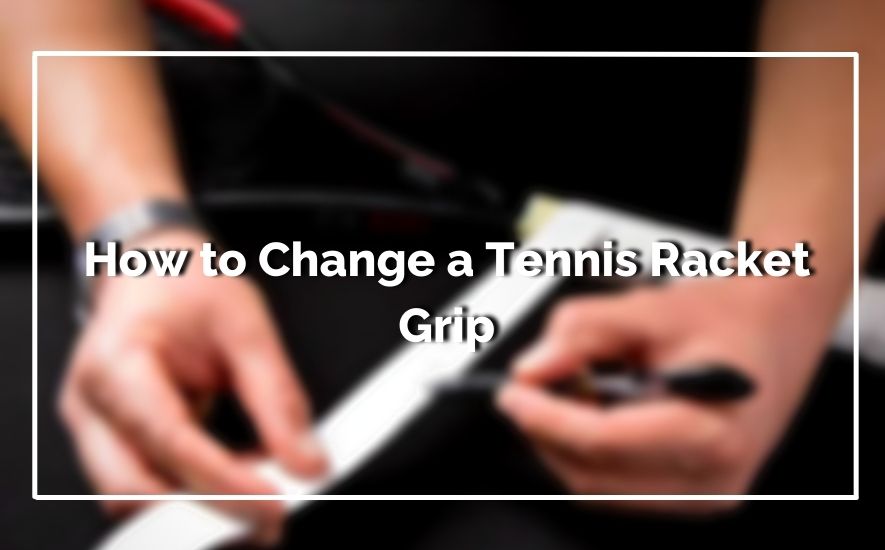Changing a tennis racket grip is an essential skill for players seeking to optimize their performance on the court. Whether you’re a seasoned pro or a casual player, having the right grip can significantly impact your game.
How To Change A Tennis Racket Grip? To change a tennis racket grip, start by removing the old grip tape and cleaning the handle. Apply the new grip tape, keeping it snug and even as you wrap it around. Finish by securing the top and replacing the end cap.
A properly fitted grip enhances control, power, and overall comfort during play, enabling you to make precise shots and adapt to different playing conditions. While it might seem like a small detail, a grip change can make a world of difference in your tennis experience.
Table of Contents
Knowing when to Change your Tennis Racket Grip
A tennis racket grip is an often overlooked yet crucial aspect of a player’s game. It connects the player to the racket, influencing control, power, and comfort during gameplay. Recognizing the right time to change your tennis racket grip is essential for maintaining optimal performance and preventing potential injuries.
Wear and Tear:
One of the most evident signs that it’s time to replace your tennis racket grip is visible wear and tear. As you continue to play, the grip’s surface will gradually degrade due to sweat, dirt, and friction.
This wear can cause the grip to become slick and slippery, compromising your ability to maintain a firm hold on the racket. Regularly inspect your grip for signs of peeling, cracking, or a smooth texture, and consider changing it once you notice these issues.
Reduced Traction and Control:
Traction and control are fundamental for executing precise shots on the tennis court. An old or worn-out grip can lead to a loss of traction, making it challenging to generate spin and maintain accuracy.
If you find yourself struggling to keep the racket steady during shots or noticing a decline in your shot-making abilities, it may be time to refresh your grip. A new grip can restore your confidence and help you regain control over your game.
Changes in Performance:
Pay attention to any noticeable changes in your on-court performance. If you’ve been experiencing a decrease in power, consistency, or overall performance, your racket grip could be a contributing factor.
Sometimes, a worn-out grip can lead to adjustments in your swing mechanics to compensate for the lack of control, inadvertently affecting your shots. By changing your grip, you can restore the natural feel of your strokes and improve your overall gameplay.
Physical Discomfort:
Physical discomfort while playing tennis is a red flag that shouldn’t be ignored. An old grip can lead to discomfort or even blisters on your hand, as the worn surface can cause friction and irritation.
If you find yourself constantly repositioning your hand on the grip during matches, or if you’re experiencing discomfort after playing, it’s a clear indication that a grip change is necessary. Prioritizing your comfort not only enhances your playing experience but also reduces the risk of injury.
Grip Size and Personal Preference:
Tennis players have different hand sizes and preferences when it comes to grip thickness. Over time, your preference may evolve or change, leading you to seek a grip that offers a better fit and feel.
Experimenting with different grip sizes and materials can help you fine-tune your playing experience and tailor your racket to your individual needs. If you’ve been curious about trying a different grip size or material, it might be a good time to explore these options.
How to Change a Tennis Racket Grip for Best Performance
Your full potential on the tennis court involves more than just skill; it’s about ensuring your equipment suits your game. Knowing how to change a tennis racket grip is a valuable skill for any player. Start by removing the old grip carefully, ensuring a clean slate for the new one. Select a grip that complements your playing style – whether you prefer a cushioned feel or enhanced control.
As you expertly wind the new grip in place, pay attention to details, such as overlap and tightness. With a fresh grip tailored to your preferences, you’ll experience a renewed connection with your racket, translating into improved comfort and performance on the court. Elevate your game by mastering the art of changing your tennis racket grip.
Choosing the Right Tennis Grip for Replacement
Tennis enthusiasts understand the profound impact a proper grip can have on their game. Whether you’re a beginner or a seasoned player, selecting the appropriate tennis grip for replacement is pivotal to maintaining control, comfort, and overall performance on the court. Here’s a breakdown of key considerations and steps to help you make an informed choice.
1. Understanding Grip Types:
Before embarking on the journey of selecting a replacement tennis grip, it’s essential to comprehend the various types available. The three primary grip styles are the Eastern, Western, and Continental grips, each with distinct advantages and applications.
The Eastern grip offers versatility and control, the Western grip is favored by topspin enthusiasts, while the Continental grip is ideal for serves and volleys. Assess your playing style and objectives to determine which grip type aligns best with your needs.
2. Evaluating Your Playing Style:
Analyzing your playing style is paramount in choosing the right grip. Are you an aggressive baseliner, a net rusher, or a balanced all-court player? Tailoring your grip selection to match your playing style can significantly enhance your gameplay. A grip that complements your strengths and addresses your weaknesses can lead to improved consistency and shot execution.
3. Assessing Comfort and Feel:
The comfort and tactile sensation of a grip play a crucial role in your overall tennis experience. While some players prefer a cushioned and slightly thicker grip for reduced vibration and enhanced comfort, others opt for a thinner grip for a more direct connection to the racket.
Experimenting with different grip thicknesses and materials can help you discover the ideal balance between comfort and tactile feedback.
4. Considering Hand Size and Grip Size:
Hand size is a pivotal factor in grip selection. A grip that’s too small can lead to excess wrist movement and lack of control, while an oversized grip can impede maneuverability and cause discomfort. Measuring your hand and consulting grip size charts provided by manufacturers can guide you in selecting a grip that fits snugly and promotes optimal wrist stability.
5. Seeking Professional Guidance:
When in doubt, seeking advice from tennis professionals or coaches can provide valuable insights into grip selection. These experts can observe your playing style, assess your grip preferences, and offer personalized recommendations tailored to your individual needs. A professional’s guidance can save you time and effort by narrowing down the options and helping you make an informed decision.
A Complete Tutorial on How to Change Your Tennis Racket Grip
Changing your tennis racket grip might seem like a daunting task, but it’s an essential skill that can significantly impact your gameplay. A properly fitted grip enhances your control, comfort, and overall performance on the court.
Choosing the Right Grip:
Before diving into the process, it’s crucial to select the right grip size and type for your playing style and hand dimensions. Grips come in various sizes, such as 4 1/8, 4 1/4, 4 3/8, and so on. To determine the correct size, measure the distance from your palm’s center to the tip of your ring finger.
Additionally, consider the material – leather, synthetic, or overgrip – based on your preferences for grip feel and moisture absorption.
Gather Your Tools:
Having the right tools at hand will streamline the grip-changing process. You’ll need a new grip, a pair of scissors, a clean cloth, grip tape, a marker, and a small knife. Lay them out on a flat surface and ensure they’re easily accessible as you proceed.
Removing the Old Grip:
Begin by carefully removing the existing grip. Using the small knife, gently cut through the tape securing the grip in place. Once the tape is removed, slowly peel off the old grip, being cautious not to damage the underlying handle. Clean the handle with a damp cloth to remove any residue and ensure a clean surface for the new grip.
Applying the New Grip:
Unroll the new grip and align it with the butt cap of the racket. Starting at the butt end, wrap the grip around the handle, ensuring a tight and even overlap with each turn. As you wrap, use the marker to mark the point where the grip meets the handle, allowing for proper alignment. Once the grip is securely wrapped, cut off any excess length using the scissors.
Securing the Grip:
To secure the new grip in place, use the grip tape. Begin by taping down the top end of the grip, just below the butt cap. Continue wrapping the tape in a spiral motion down the grip, overlapping each turn slightly. Make sure the tape is taut but not overly tight. When you reach the marked point, trim the tape and press it down to create a neat finish.
Maintaining Your Tennis Racket Grip
Tennis is a sport that demands precision, control, and agility, and a crucial element of achieving this is maintaining a proper grip on your racket. Your racket’s grip not only impacts your playing style but also influences your overall performance on the court.
1. Regular Cleaning and Inspection:
Just as you maintain your racket strings, the grip also requires attention. Regularly clean the grip to remove sweat, dirt, and oil buildup that can cause it to become slippery and affect your grip.
Use a damp cloth with mild soap to gently wipe the grip, ensuring not to saturate it excessively. Additionally, inspect the grip for signs of wear, such as cracks or tears. Replacing the grip when necessary will enhance your playing experience and prevent accidents during a match.
2. Proper Storage:
Storing your racket in the right conditions can significantly extend the lifespan of your grip. Avoid leaving your racket exposed to extreme temperatures, direct sunlight, or damp environments.
High heat can cause the grip material to deteriorate, while moisture can lead to mold and mildew growth. Invest in a protective cover or case to shield your racket from environmental factors when not in use, ensuring that the grip remains in optimal condition.
3. Grip Rotation:
Frequent and rigorous use of your racket can cause uneven wear on the grip. To prevent this, practice grip rotation.
By periodically changing the orientation of the racket in your hand, you distribute the wear more evenly across the grip. This simple technique not only prolongs the life of the grip but also maintains a consistent feel and comfort during your matches.
4. Overgrips:
Using overgrips is a popular strategy among tennis players to both protect the original grip and customize the feel of the racket. Overgrips are thin, cushioned materials that are wrapped over the existing grip.
They provide additional comfort, absorb moisture, and offer players the opportunity to experiment with different textures and thicknesses. Regularly replacing overgrips can help you maintain a fresh and effective grip on your racket.
5. Personalization and Maintenance:
Your grip preferences may change over time as you refine your playing style. Experimenting with various grip sizes, materials, and textures can help you find what suits you best. Consulting with a tennis coach or a professional can provide valuable insights into finding the ideal grip that enhances your performance.
Furthermore, pay attention to how you hold the racket during different shots and adjust your grip accordingly. Consistently monitoring and adapting your grip technique will not only optimize your playing experience but also prevent strain and injuries.
Grip Size Adjustment for Tennis Rackets
Selecting the appropriate grip size for your tennis racket is a crucial aspect that significantly impacts your performance on the court. A well-suited grip size not only enhances comfort and control but also reduces the risk of injuries.
Importance of Grip Size
The grip size of a tennis racket plays a pivotal role in a player’s overall experience and effectiveness during a match. A grip that is too small might lead to excessive wrist movement, resulting in a lack of stability and control over shots.
On the other hand, an excessively large grip can strain the forearm and restrict fluid motion. It’s essential to find a balance that complements your playing style, physique, and technique.
Determining the Right Grip Size
Discovering the ideal grip size involves a personalized approach. One way to gauge the proper size is by assessing your hand size. Measuring from the middle crease of your palm to the tip of your ring finger can provide a general idea of your grip size. However, it’s advisable to factor in personal preferences and playing style. Players who favor a more powerful game may opt for a slightly larger grip, while those focused on finesse might lean toward a smaller size.
Methods of Grip Size Adjustment
There are several methods to adjust the grip size of a tennis racket to ensure a snug fit. One common technique is using overgrips or replacement grips. Overgrips are thin wraps that can be applied over the existing grip to increase its size slightly.
Replacement grips involve removing the current grip and replacing it with a new one of your desired thickness. Both methods allow for incremental adjustments, letting you fine-tune your grip for optimal performance.
Effects of Proper Grip Size
A well-fitted grip size can lead to a myriad of positive outcomes on the court. Firstly, it promotes better control over shots, enabling more accurate ball placement and improved consistency.
Secondly, it reduces the risk of injuries such as tennis elbow or wrist strain by maintaining a balanced and ergonomic grip. Lastly, a suitable grip size enhances comfort, allowing players to focus on their game without the distraction of discomfort or unease.
Conclusion
In the game of tennis, where precision and control matter, mastering the art of changing a racket grip is a crucial skill. Just like a symphony conductor fine-tunes each instrument, a player’s grip can harmonize with their playing style.
As you embark on this journey of customization, remember that a well-fitted grip can be your secret weapon on the court, elevating your performance and confounding your opponents.
So, with a dash of patience, a sprinkle of practice, and a touch of experimentation, you’re ready to wield your racket with a grip that’s uniquely yours. Play on, the maestro of the tennis court!



